Biology Assignment: Questions and Answers on the Digestive System
VerifiedAdded on 2020/03/02
|7
|1474
|338
Homework Assignment
AI Summary
This biology assignment presents a comprehensive overview of the human digestive system. It begins with labeling the parts of the digestive system and then explores the functions of salivary glands, esophagus, stomach, duodenum, ileum, and large intestine. The assignment delves into the process of peristalsis, explaining the roles of circular and longitudinal muscles in moving food through the digestive tract. It further elaborates on the functions of villi in the ileum, including their structure and how they increase nutrient absorption. The assignment includes a labeled diagram of a villus and describes how its structure facilitates its function in absorption. The provided answers cover key concepts such as the role of enzymes, the movement of food, and the absorption of nutrients, making it a valuable resource for biology students.
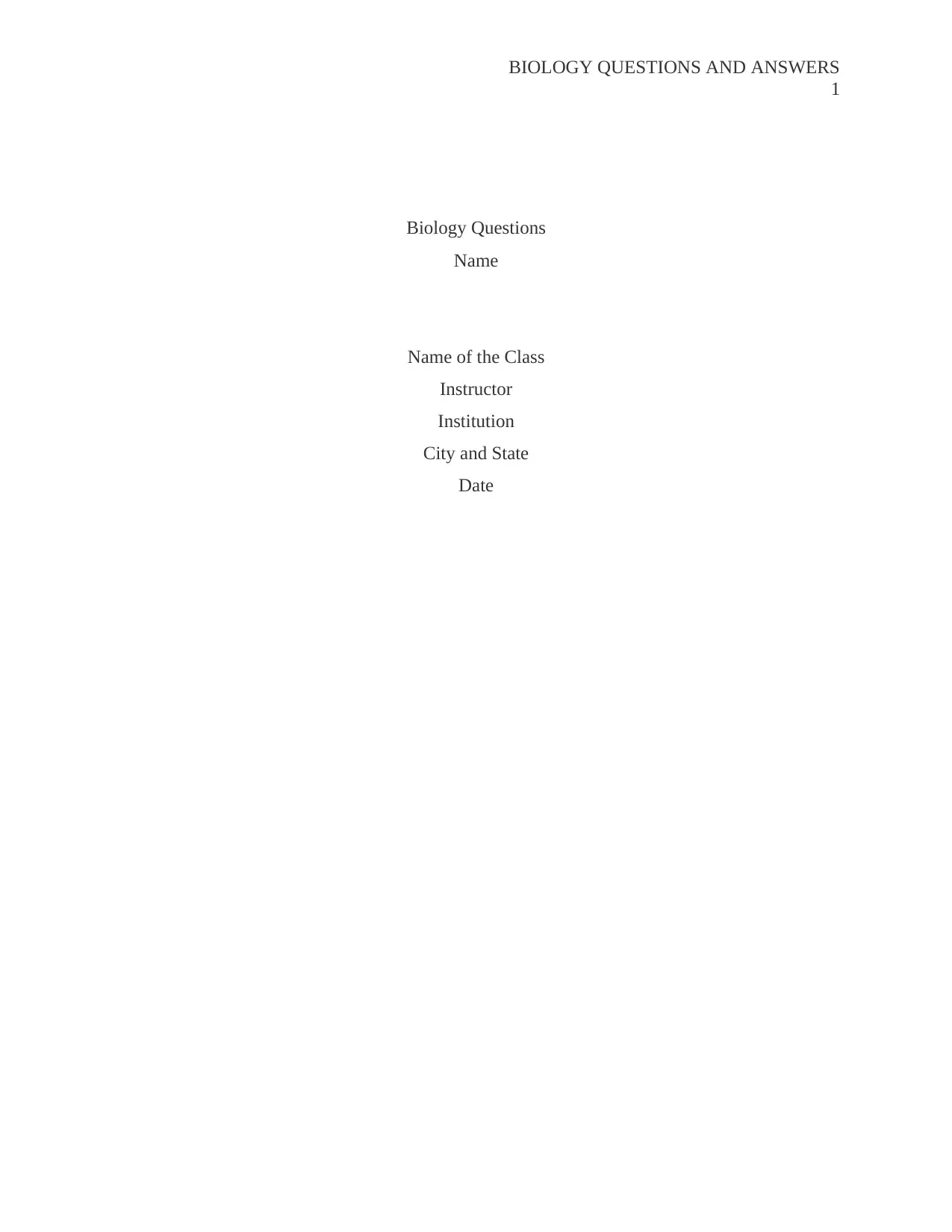
BIOLOGY QUESTIONS AND ANSWERS
1
Biology Questions
Name
Name of the Class
Instructor
Institution
City and State
Date
1
Biology Questions
Name
Name of the Class
Instructor
Institution
City and State
Date
Paraphrase This Document
Need a fresh take? Get an instant paraphrase of this document with our AI Paraphraser
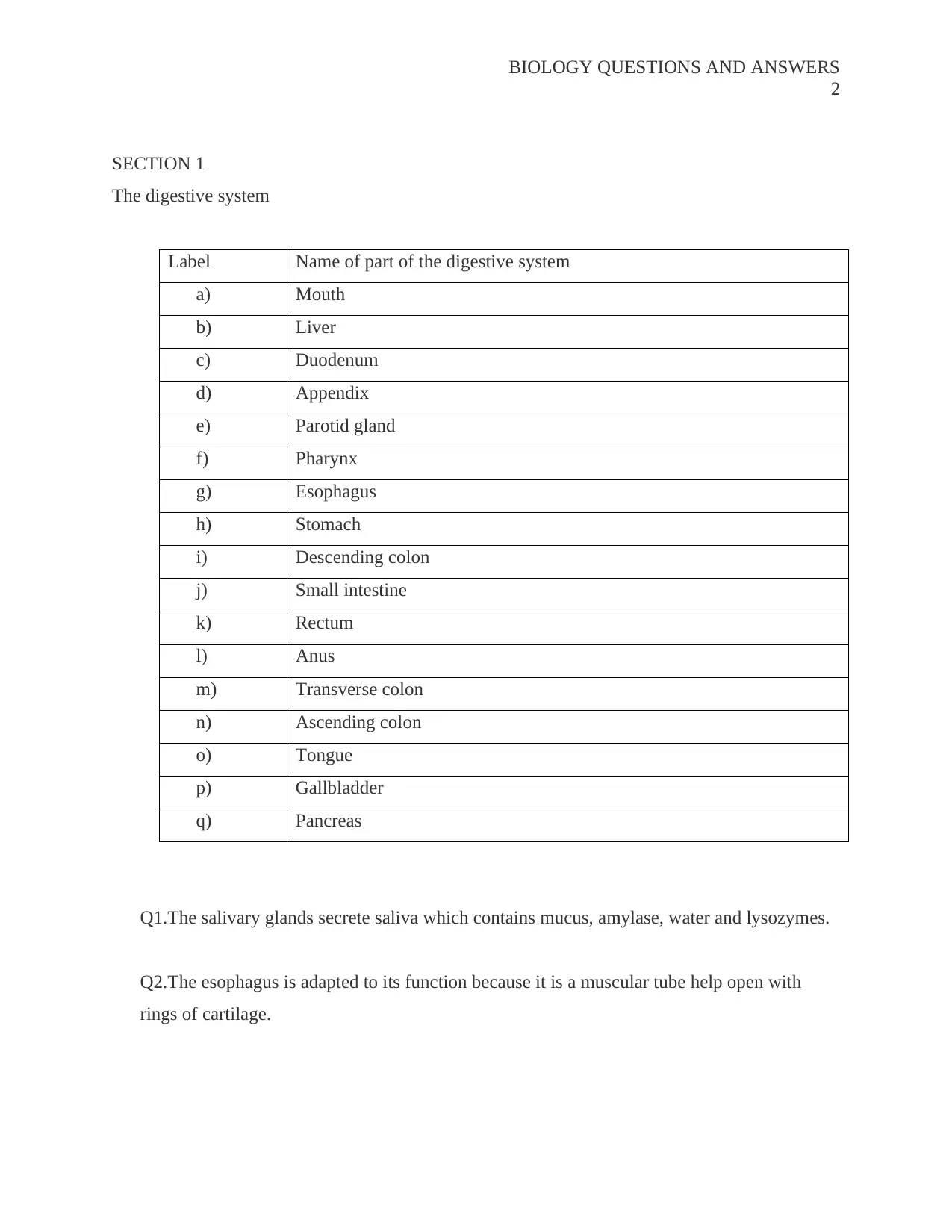
BIOLOGY QUESTIONS AND ANSWERS
2
SECTION 1
The digestive system
Label Name of part of the digestive system
a) Mouth
b) Liver
c) Duodenum
d) Appendix
e) Parotid gland
f) Pharynx
g) Esophagus
h) Stomach
i) Descending colon
j) Small intestine
k) Rectum
l) Anus
m) Transverse colon
n) Ascending colon
o) Tongue
p) Gallbladder
q) Pancreas
Q1.The salivary glands secrete saliva which contains mucus, amylase, water and lysozymes.
Q2.The esophagus is adapted to its function because it is a muscular tube help open with
rings of cartilage.
2
SECTION 1
The digestive system
Label Name of part of the digestive system
a) Mouth
b) Liver
c) Duodenum
d) Appendix
e) Parotid gland
f) Pharynx
g) Esophagus
h) Stomach
i) Descending colon
j) Small intestine
k) Rectum
l) Anus
m) Transverse colon
n) Ascending colon
o) Tongue
p) Gallbladder
q) Pancreas
Q1.The salivary glands secrete saliva which contains mucus, amylase, water and lysozymes.
Q2.The esophagus is adapted to its function because it is a muscular tube help open with
rings of cartilage.
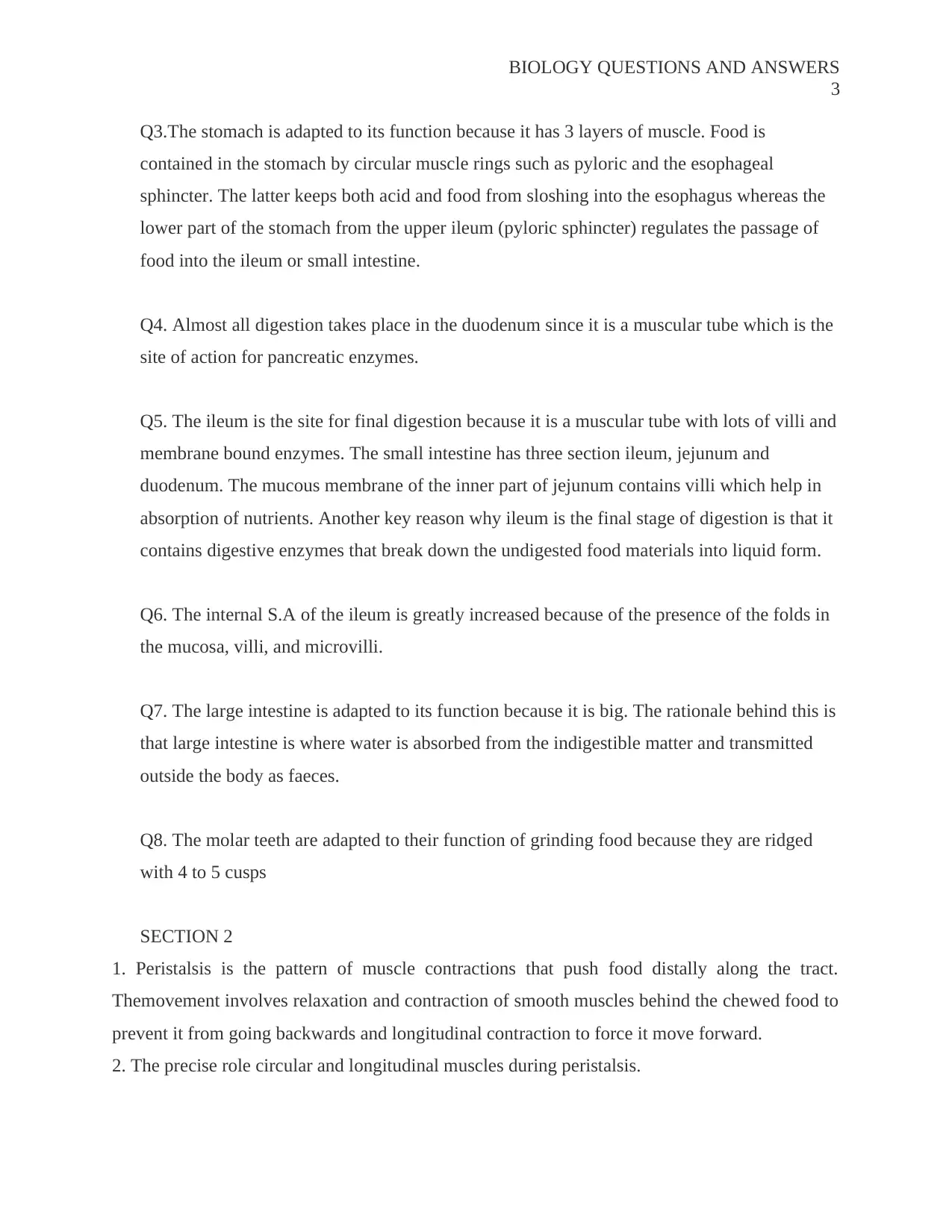
BIOLOGY QUESTIONS AND ANSWERS
3
Q3.The stomach is adapted to its function because it has 3 layers of muscle. Food is
contained in the stomach by circular muscle rings such as pyloric and the esophageal
sphincter. The latter keeps both acid and food from sloshing into the esophagus whereas the
lower part of the stomach from the upper ileum (pyloric sphincter) regulates the passage of
food into the ileum or small intestine.
Q4. Almost all digestion takes place in the duodenum since it is a muscular tube which is the
site of action for pancreatic enzymes.
Q5. The ileum is the site for final digestion because it is a muscular tube with lots of villi and
membrane bound enzymes. The small intestine has three section ileum, jejunum and
duodenum. The mucous membrane of the inner part of jejunum contains villi which help in
absorption of nutrients. Another key reason why ileum is the final stage of digestion is that it
contains digestive enzymes that break down the undigested food materials into liquid form.
Q6. The internal S.A of the ileum is greatly increased because of the presence of the folds in
the mucosa, villi, and microvilli.
Q7. The large intestine is adapted to its function because it is big. The rationale behind this is
that large intestine is where water is absorbed from the indigestible matter and transmitted
outside the body as faeces.
Q8. The molar teeth are adapted to their function of grinding food because they are ridged
with 4 to 5 cusps
SECTION 2
1. Peristalsis is the pattern of muscle contractions that push food distally along the tract.
Themovement involves relaxation and contraction of smooth muscles behind the chewed food to
prevent it from going backwards and longitudinal contraction to force it move forward.
2. The precise role circular and longitudinal muscles during peristalsis.
3
Q3.The stomach is adapted to its function because it has 3 layers of muscle. Food is
contained in the stomach by circular muscle rings such as pyloric and the esophageal
sphincter. The latter keeps both acid and food from sloshing into the esophagus whereas the
lower part of the stomach from the upper ileum (pyloric sphincter) regulates the passage of
food into the ileum or small intestine.
Q4. Almost all digestion takes place in the duodenum since it is a muscular tube which is the
site of action for pancreatic enzymes.
Q5. The ileum is the site for final digestion because it is a muscular tube with lots of villi and
membrane bound enzymes. The small intestine has three section ileum, jejunum and
duodenum. The mucous membrane of the inner part of jejunum contains villi which help in
absorption of nutrients. Another key reason why ileum is the final stage of digestion is that it
contains digestive enzymes that break down the undigested food materials into liquid form.
Q6. The internal S.A of the ileum is greatly increased because of the presence of the folds in
the mucosa, villi, and microvilli.
Q7. The large intestine is adapted to its function because it is big. The rationale behind this is
that large intestine is where water is absorbed from the indigestible matter and transmitted
outside the body as faeces.
Q8. The molar teeth are adapted to their function of grinding food because they are ridged
with 4 to 5 cusps
SECTION 2
1. Peristalsis is the pattern of muscle contractions that push food distally along the tract.
Themovement involves relaxation and contraction of smooth muscles behind the chewed food to
prevent it from going backwards and longitudinal contraction to force it move forward.
2. The precise role circular and longitudinal muscles during peristalsis.
⊘ This is a preview!⊘
Do you want full access?
Subscribe today to unlock all pages.

Trusted by 1+ million students worldwide
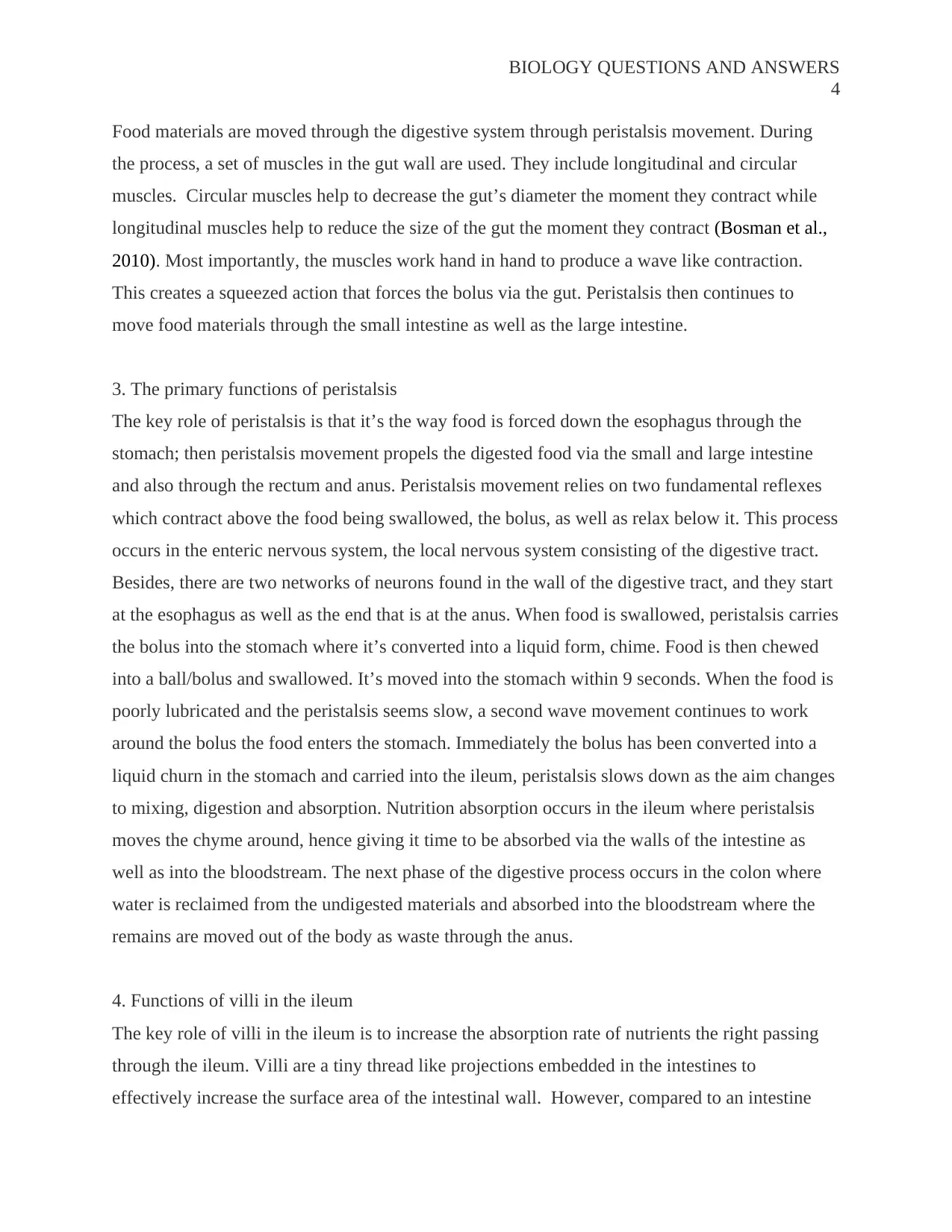
BIOLOGY QUESTIONS AND ANSWERS
4
Food materials are moved through the digestive system through peristalsis movement. During
the process, a set of muscles in the gut wall are used. They include longitudinal and circular
muscles. Circular muscles help to decrease the gut’s diameter the moment they contract while
longitudinal muscles help to reduce the size of the gut the moment they contract (Bosman et al.,
2010). Most importantly, the muscles work hand in hand to produce a wave like contraction.
This creates a squeezed action that forces the bolus via the gut. Peristalsis then continues to
move food materials through the small intestine as well as the large intestine.
3. The primary functions of peristalsis
The key role of peristalsis is that it’s the way food is forced down the esophagus through the
stomach; then peristalsis movement propels the digested food via the small and large intestine
and also through the rectum and anus. Peristalsis movement relies on two fundamental reflexes
which contract above the food being swallowed, the bolus, as well as relax below it. This process
occurs in the enteric nervous system, the local nervous system consisting of the digestive tract.
Besides, there are two networks of neurons found in the wall of the digestive tract, and they start
at the esophagus as well as the end that is at the anus. When food is swallowed, peristalsis carries
the bolus into the stomach where it’s converted into a liquid form, chime. Food is then chewed
into a ball/bolus and swallowed. It’s moved into the stomach within 9 seconds. When the food is
poorly lubricated and the peristalsis seems slow, a second wave movement continues to work
around the bolus the food enters the stomach. Immediately the bolus has been converted into a
liquid churn in the stomach and carried into the ileum, peristalsis slows down as the aim changes
to mixing, digestion and absorption. Nutrition absorption occurs in the ileum where peristalsis
moves the chyme around, hence giving it time to be absorbed via the walls of the intestine as
well as into the bloodstream. The next phase of the digestive process occurs in the colon where
water is reclaimed from the undigested materials and absorbed into the bloodstream where the
remains are moved out of the body as waste through the anus.
4. Functions of villi in the ileum
The key role of villi in the ileum is to increase the absorption rate of nutrients the right passing
through the ileum. Villi are a tiny thread like projections embedded in the intestines to
effectively increase the surface area of the intestinal wall. However, compared to an intestine
4
Food materials are moved through the digestive system through peristalsis movement. During
the process, a set of muscles in the gut wall are used. They include longitudinal and circular
muscles. Circular muscles help to decrease the gut’s diameter the moment they contract while
longitudinal muscles help to reduce the size of the gut the moment they contract (Bosman et al.,
2010). Most importantly, the muscles work hand in hand to produce a wave like contraction.
This creates a squeezed action that forces the bolus via the gut. Peristalsis then continues to
move food materials through the small intestine as well as the large intestine.
3. The primary functions of peristalsis
The key role of peristalsis is that it’s the way food is forced down the esophagus through the
stomach; then peristalsis movement propels the digested food via the small and large intestine
and also through the rectum and anus. Peristalsis movement relies on two fundamental reflexes
which contract above the food being swallowed, the bolus, as well as relax below it. This process
occurs in the enteric nervous system, the local nervous system consisting of the digestive tract.
Besides, there are two networks of neurons found in the wall of the digestive tract, and they start
at the esophagus as well as the end that is at the anus. When food is swallowed, peristalsis carries
the bolus into the stomach where it’s converted into a liquid form, chime. Food is then chewed
into a ball/bolus and swallowed. It’s moved into the stomach within 9 seconds. When the food is
poorly lubricated and the peristalsis seems slow, a second wave movement continues to work
around the bolus the food enters the stomach. Immediately the bolus has been converted into a
liquid churn in the stomach and carried into the ileum, peristalsis slows down as the aim changes
to mixing, digestion and absorption. Nutrition absorption occurs in the ileum where peristalsis
moves the chyme around, hence giving it time to be absorbed via the walls of the intestine as
well as into the bloodstream. The next phase of the digestive process occurs in the colon where
water is reclaimed from the undigested materials and absorbed into the bloodstream where the
remains are moved out of the body as waste through the anus.
4. Functions of villi in the ileum
The key role of villi in the ileum is to increase the absorption rate of nutrients the right passing
through the ileum. Villi are a tiny thread like projections embedded in the intestines to
effectively increase the surface area of the intestinal wall. However, compared to an intestine
Paraphrase This Document
Need a fresh take? Get an instant paraphrase of this document with our AI Paraphraser
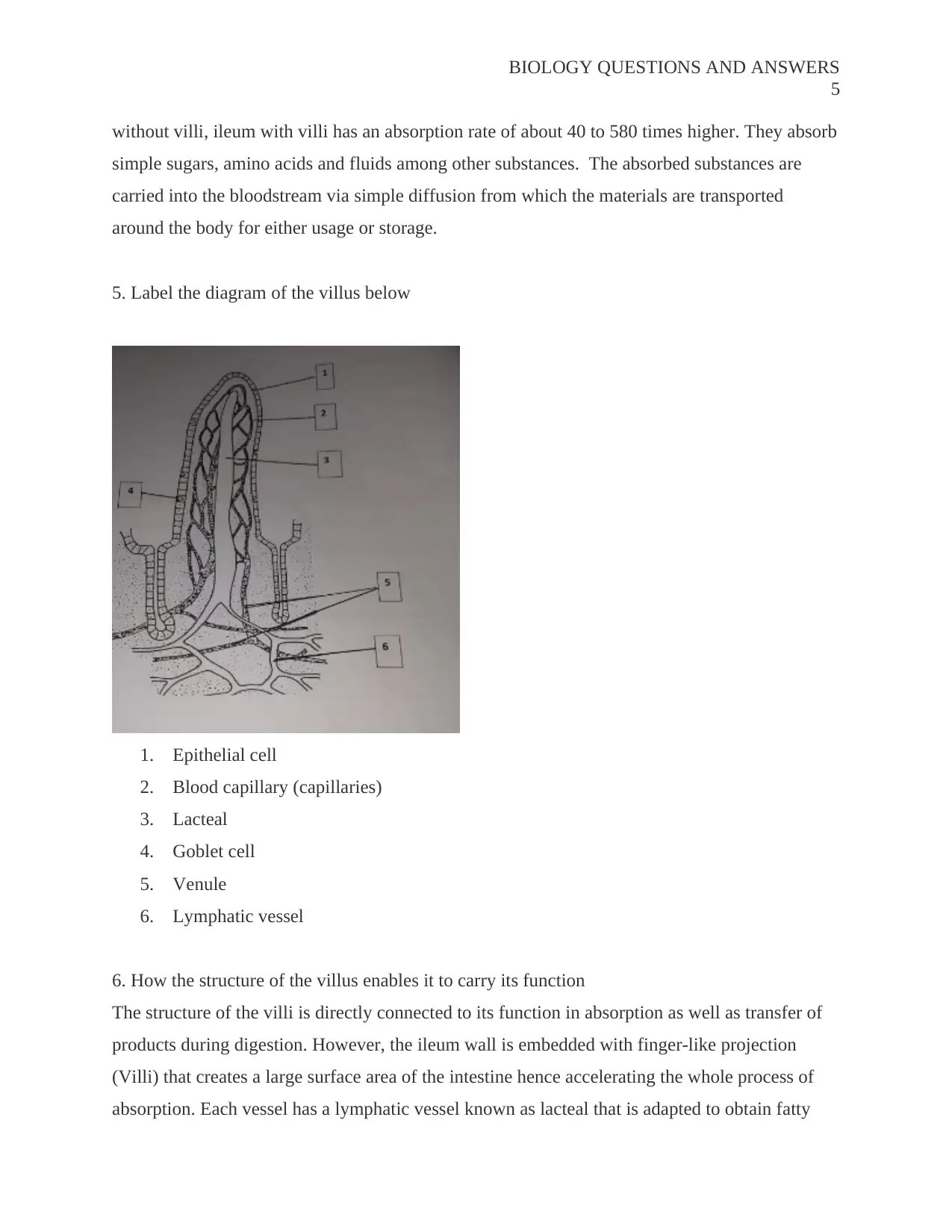
BIOLOGY QUESTIONS AND ANSWERS
5
without villi, ileum with villi has an absorption rate of about 40 to 580 times higher. They absorb
simple sugars, amino acids and fluids among other substances. The absorbed substances are
carried into the bloodstream via simple diffusion from which the materials are transported
around the body for either usage or storage.
5. Label the diagram of the villus below
1. Epithelial cell
2. Blood capillary (capillaries)
3. Lacteal
4. Goblet cell
5. Venule
6. Lymphatic vessel
6. How the structure of the villus enables it to carry its function
The structure of the villi is directly connected to its function in absorption as well as transfer of
products during digestion. However, the ileum wall is embedded with finger-like projection
(Villi) that creates a large surface area of the intestine hence accelerating the whole process of
absorption. Each vessel has a lymphatic vessel known as lacteal that is adapted to obtain fatty
5
without villi, ileum with villi has an absorption rate of about 40 to 580 times higher. They absorb
simple sugars, amino acids and fluids among other substances. The absorbed substances are
carried into the bloodstream via simple diffusion from which the materials are transported
around the body for either usage or storage.
5. Label the diagram of the villus below
1. Epithelial cell
2. Blood capillary (capillaries)
3. Lacteal
4. Goblet cell
5. Venule
6. Lymphatic vessel
6. How the structure of the villus enables it to carry its function
The structure of the villi is directly connected to its function in absorption as well as transfer of
products during digestion. However, the ileum wall is embedded with finger-like projection
(Villi) that creates a large surface area of the intestine hence accelerating the whole process of
absorption. Each vessel has a lymphatic vessel known as lacteal that is adapted to obtain fatty
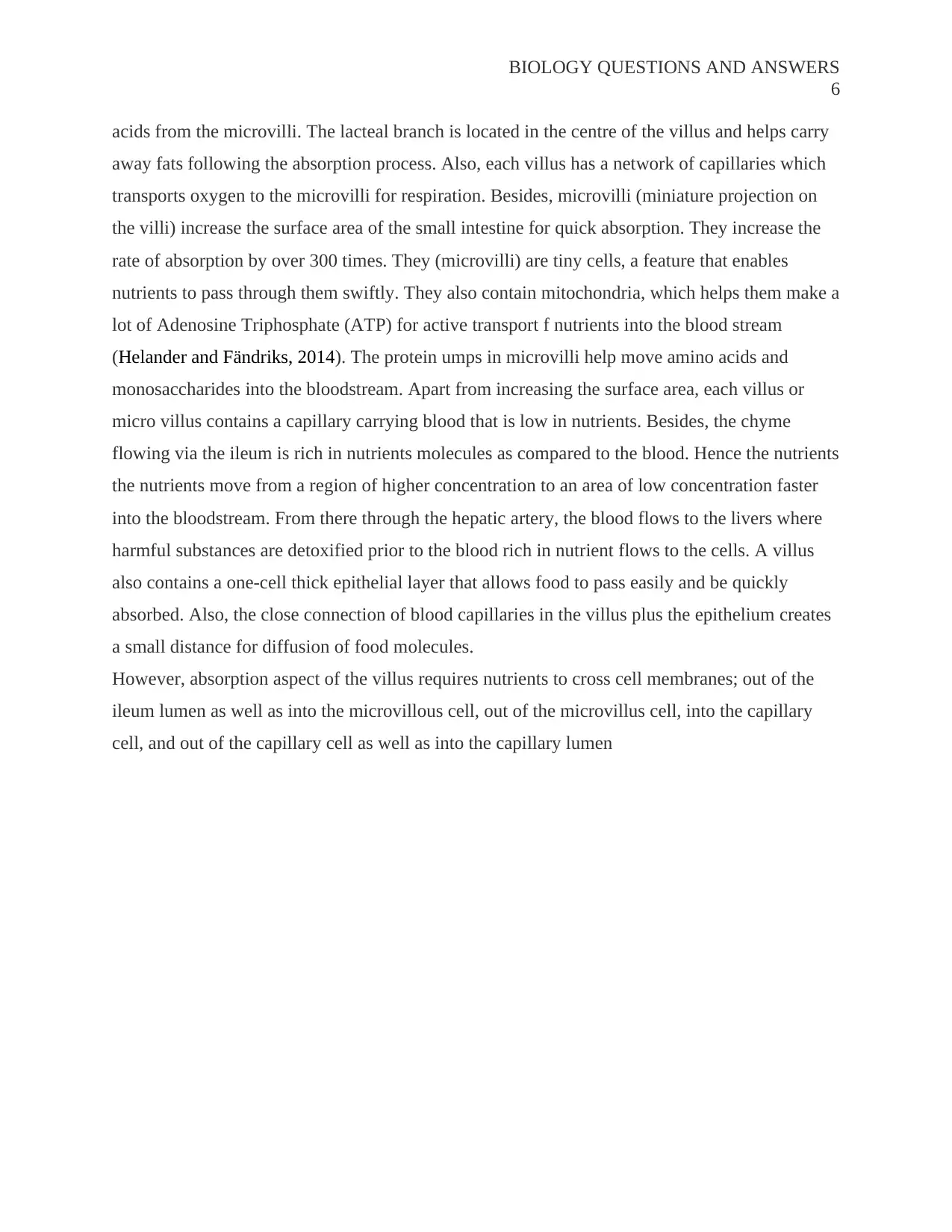
BIOLOGY QUESTIONS AND ANSWERS
6
acids from the microvilli. The lacteal branch is located in the centre of the villus and helps carry
away fats following the absorption process. Also, each villus has a network of capillaries which
transports oxygen to the microvilli for respiration. Besides, microvilli (miniature projection on
the villi) increase the surface area of the small intestine for quick absorption. They increase the
rate of absorption by over 300 times. They (microvilli) are tiny cells, a feature that enables
nutrients to pass through them swiftly. They also contain mitochondria, which helps them make a
lot of Adenosine Triphosphate (ATP) for active transport f nutrients into the blood stream
(Helander and Fändriks, 2014). The protein umps in microvilli help move amino acids and
monosaccharides into the bloodstream. Apart from increasing the surface area, each villus or
micro villus contains a capillary carrying blood that is low in nutrients. Besides, the chyme
flowing via the ileum is rich in nutrients molecules as compared to the blood. Hence the nutrients
the nutrients move from a region of higher concentration to an area of low concentration faster
into the bloodstream. From there through the hepatic artery, the blood flows to the livers where
harmful substances are detoxified prior to the blood rich in nutrient flows to the cells. A villus
also contains a one-cell thick epithelial layer that allows food to pass easily and be quickly
absorbed. Also, the close connection of blood capillaries in the villus plus the epithelium creates
a small distance for diffusion of food molecules.
However, absorption aspect of the villus requires nutrients to cross cell membranes; out of the
ileum lumen as well as into the microvillous cell, out of the microvillus cell, into the capillary
cell, and out of the capillary cell as well as into the capillary lumen
6
acids from the microvilli. The lacteal branch is located in the centre of the villus and helps carry
away fats following the absorption process. Also, each villus has a network of capillaries which
transports oxygen to the microvilli for respiration. Besides, microvilli (miniature projection on
the villi) increase the surface area of the small intestine for quick absorption. They increase the
rate of absorption by over 300 times. They (microvilli) are tiny cells, a feature that enables
nutrients to pass through them swiftly. They also contain mitochondria, which helps them make a
lot of Adenosine Triphosphate (ATP) for active transport f nutrients into the blood stream
(Helander and Fändriks, 2014). The protein umps in microvilli help move amino acids and
monosaccharides into the bloodstream. Apart from increasing the surface area, each villus or
micro villus contains a capillary carrying blood that is low in nutrients. Besides, the chyme
flowing via the ileum is rich in nutrients molecules as compared to the blood. Hence the nutrients
the nutrients move from a region of higher concentration to an area of low concentration faster
into the bloodstream. From there through the hepatic artery, the blood flows to the livers where
harmful substances are detoxified prior to the blood rich in nutrient flows to the cells. A villus
also contains a one-cell thick epithelial layer that allows food to pass easily and be quickly
absorbed. Also, the close connection of blood capillaries in the villus plus the epithelium creates
a small distance for diffusion of food molecules.
However, absorption aspect of the villus requires nutrients to cross cell membranes; out of the
ileum lumen as well as into the microvillous cell, out of the microvillus cell, into the capillary
cell, and out of the capillary cell as well as into the capillary lumen
⊘ This is a preview!⊘
Do you want full access?
Subscribe today to unlock all pages.

Trusted by 1+ million students worldwide

BIOLOGY QUESTIONS AND ANSWERS
7
REFERENCE LIST
Bosman, F.T., Carneiro, F., Hruban, R.H. and Theise, N.D., 2010. WHO classification of
tumours of the digestive system (No. Ed. 4). World Health Organization.
Helander, H.F. and Fändriks, L., 2014. Surface area of the digestive tract–revisited.
Scandinavian journal of gastroenterology, 49(6), pp.681-689.
7
REFERENCE LIST
Bosman, F.T., Carneiro, F., Hruban, R.H. and Theise, N.D., 2010. WHO classification of
tumours of the digestive system (No. Ed. 4). World Health Organization.
Helander, H.F. and Fändriks, L., 2014. Surface area of the digestive tract–revisited.
Scandinavian journal of gastroenterology, 49(6), pp.681-689.
1 out of 7
Related Documents
Your All-in-One AI-Powered Toolkit for Academic Success.
+13062052269
info@desklib.com
Available 24*7 on WhatsApp / Email
![[object Object]](/_next/static/media/star-bottom.7253800d.svg)
Unlock your academic potential
Copyright © 2020–2025 A2Z Services. All Rights Reserved. Developed and managed by ZUCOL.





